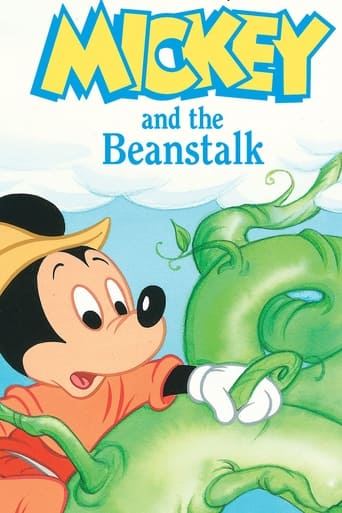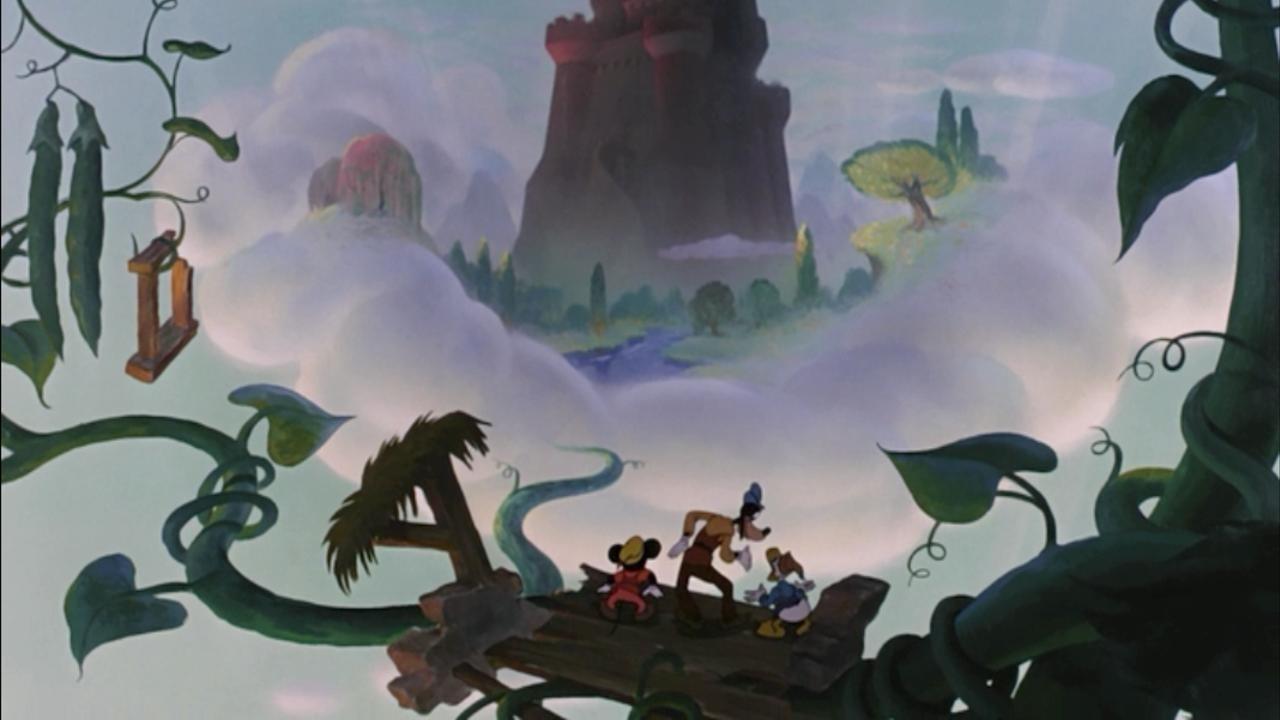OllieSuave-007
Mickey, Donald and Goofy take on the Jack and the Beanstalk fairy-tale, starring as poor, starving farmers of Happy Valley who discovered a beanstalk that grew from the beans Mickey got after trading in their cow. They stumble upon the beautiful Golden Harp who after being kidnapped by the Giant lead to the decline of the once prosperous Happy Valley. As a result, the trio go on a daring mission to rescue the harp and restore prosperity to their valley.It's a beautifully animated story with full in-character laughs from Mickey, Donald and Goofy. Mickey is his heroic self while Goofy tries hard not to blunder on things. Donald is hilarious as heck, from him going crazy while starving to him parodying an army sharp shooter. The giant was menacing, but goofy looking, and the Golden Harp was beautiful with her soothing singing voice.There's plenty of adventures in this exciting rescue-the-harp plot. It's non-stop fun you would expect in a cartoon movie from beginning to end.Grade A
Horst in Translation (filmreviews@web.de)
This is one of the longest 1940's animated short films by Disney and in general (including also the other companies like Warner Bros). Usually they're around 6-7 minutes, but this one stands at a whooping 28 minutes to do the story justice. It switches occasionally back to the narrator who also, as an introduction, tells us a bit on crucial characters from previous Disney feature films such as Pinocchio and Snow White.When the real story begins, we see a harp-lady with a beautiful voice being kidnapped and thus the happy valley she used to sing for sinks into despair. Action switches to our heroes Mickey, Goofy and Donald who show the possibly best portrayal of starvation ever put in an animated movie. When Micky exchanged their proper meal for a handful of magic beanstalks, they, all of a sudden, end up on a distant world in the sky where they pretty much have the size like midges and butterflies.They approach a large castle and not only find lots of delicious food (Goofy in the jelly is a highlight), but also the abducted harp and the magically skilled, but daft, ginger giant who kidnapped her. Their initial plan of tricking the giant into turning himself into a fly and kill him with a swatter fails, but the harp-lady can manage to sing him to sleep, so the trio and her successfully escape the castle and revive Happy Valley. It's a thoroughly recommendable short film and certainly not only to children.
LanceStudsteele
When I first viewed Mickey and the Beanstalk with my toddler son approximately 16 years ago, I saw it as more than a retelling of an old fairy tale. Later, while watching a documentary about the devastation wrought upon a real life "Happy Valley", the Owens River Valley, I was reminded of my initial impression of the back story of this short film - the drought and desolation in Happy Valley caused by the theft of the harp as a veiled metaphor for the appropriation of water resources by the GIANT burgeoning metropolis of Los Angeles under the direction of "Willie" Mulholland. Streams and brooks sing or are musical in their own way. Diversion of riparian resources can cause calamity. A giant municipality that diverts water for its own use can leave the former beneficiaries of those resources woefully lacking the wherewithal to prosper or even survive.If the writers used the foundation for the plot of this short animated film as an opportunity for political protest or commentary, they may have done so secretly, fearing that their theme might be edited from the film or that they might suffer reprisal. I'd like to believe that Walt Disney, whom I believe had a social conscience, left the metaphor in the film but didn't publicize it so as not to cause undue controversy around a film that was intended as children's entertainment. I'd appreciate comments about this subject, especially from anyone who has knowledge of the intentions of the writers, directors, or producer.
Ron Oliver
A Walt Disney MICKEY MOUSE Cartoon.Three zany farmers - Mickey, Donald & Goofy - attempt to rescue the stolen Singing Harp from a temperamental giant.While it technically does not match the quality of their classic cartoons from the 1930's, MICKEY AND THE BEANSTALK is a most enjoyable two-reeler and provides the trio with one of their liveliest adventures. The sequence of the growing beanstalk up lifting & breaking apart the farmhouse is pure magic. Comic veteran Billy Gilbert provides the voice for Willie the Giant; Clarence Nash does the honors for Donald.Disney has produced at least three versions of this cartoon. Originally it was the concluding half of FUN AND FANCY FREE (1947) and was narrated by the marvelous Edgar Bergen with assistance from Charlie McCarthy & Mortimer Snerd. There is also a version narrated by Paul Frees in the character of Professor Ludwig von Drake. Finally, there is a version of the cartoon narrated by Sterling Holloway.Walt Disney (1901-1966) was always intrigued by pictures & drawings. As a lad in Marceline, Missouri, he sketched farm animals on scraps of paper; later, as an ambulance driver in France during the First World War, he drew comic figures on the sides of his vehicle. Back in Kansas City, along with artist Ub Iwerks, Walt developed a primitive animation studio that provided animated commercials and tiny cartoons for the local movie theaters. Always the innovator, his ALICE IN CARTOONLAND series broke ground in placing a live figure in a cartoon universe. Business reversals sent Disney & Iwerks to Hollywood in 1923, where Walt's older brother Roy became his lifelong business manager & counselor. When a mildly successful series with Oswald The Lucky Rabbit was snatched away by the distributor, the character of Mickey Mouse sprung into Walt's imagination, ensuring Disney's immortality. The happy arrival of sound technology made Mickey's screen debut, STEAMBOAT WILLIE (1928), a tremendous audience success with its use of synchronized music. The SILLY SYMPHONIES soon appeared, and Walt's growing crew of marvelously talented animators were quickly conquering new territory with full color, illusions of depth and radical advancements in personality development, an arena in which Walt's genius was unbeatable. Mickey's feisty, naughty behavior had captured millions of fans, but he was soon to be joined by other animated companions: temperamental Donald Duck, intellectually-challenged Goofy and energetic Pluto. All this was in preparation for Walt's grandest dream - feature length animated films. Against a blizzard of doomsayers, Walt persevered and over the next decades delighted children of all ages with the adventures of Snow White, Pinocchio, Dumbo, Bambi & Peter Pan. Walt never forgot that his fortunes were all started by a mouse, or that childlike simplicity of message and lots of hard work always pay off.


 AD
AD



